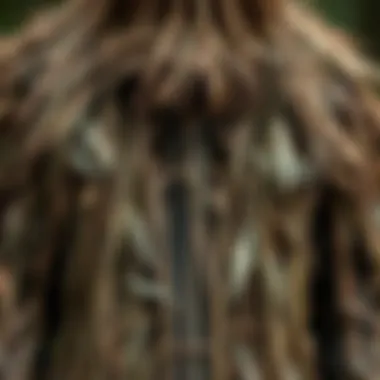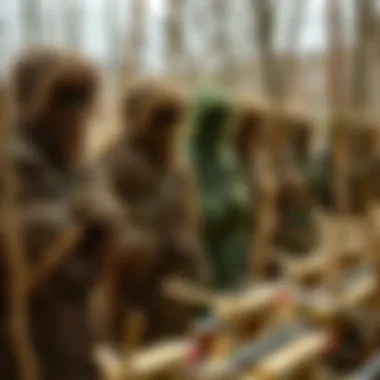In-Depth Guide to Men's Ghillie Suits for Every Adventure


Intro
The world of men’s ghillie suits is both fascinating and practical, nestled at the crossroads of fashion and functionality. Historically, these suits served a life-or-death purpose, primarily in military and hunting scenarios. However, beyond their critical applications, they also reflect a unique style that has caught the eye of outdoor enthusiasts and fashion-minded individuals alike.
Ghillie suits are designed to mimic the natural environment, effectively blending the wearer into their surroundings. The intricate layering of materials and textures makes them not just a piece of gear, but also a statement—one that speaks to an appreciation for nature and the art of camouflage. As more people venture into outdoor activities, understanding the nuances of ghillie suits becomes paramount for those looking to enhance their experiences without drawing unwanted attention.
This guide is meant to equip you with comprehensive knowledge about men’s ghillie suits, focusing on their construction, material choices, and best uses in various environments. You'll find practical maintenance tips and learn how to personalize your suit, ensuring you stand out for all the right reasons.
Rather than following trends blindly, understanding these suits' functionalities allows for a more informed selection—one that caters not just to aesthetics but also to durability and comfort in the great outdoors.
Understanding Ghillie Suits
The world of ghillie suits is one that melds tradition with tactical necessity. Understanding ghillie suits goes beyond mere aesthetics; it dives deep into functionality and purpose. These garments are not just pieces of clothing; they represent an intricate blend of design and nature, aimed at blending the wearer seamlessly into their surrounding environment. In discussions about hunting or military strategies, recognizing the distinct advantages of ghillie suits can provide significant benefits to one's effectiveness in various outdoor pursuits.
Definition and Purpose
To define a ghillie suit, think of it as a specialized camouflage garment. It's crafted from a variety of materials, typically a base of netting or burlap, adorned with natural or synthetic foliage attachments. The purpose? To create a visual disconnect in the eyes of the observer. This disruption in outline and coloration helps the wearer to blend into their surroundings, whether it be in dense woods or sprawling open fields. In the scope of hunting, military operations, or even wildlife photography, the ghillie suit serves as an essential layer of concealment.
Furthermore, the versatility of ghillie suits extends to different environments. Depending on how they are constructed—whether with natural elements like leaves and branches or synthetic fibers that mimic various textures—the wearer's probability of remaining undetected increases exponentially. This functionality becomes particularly relevant in high-stakes scenarios where stealth can mean the difference between success and failure.
Historical Context
The origins of the ghillie suit can be traced back to military applications, but its roots run even deeper. The name "ghillie" comes from the Scottish term for a servant or guide, specifically in the context of hunting in the Scottish Highlands. Traditionally, the Highland gamekeepers would use clothing made from local materials, designed to help them blend into their natural surroundings while tracking game.
During World War I and later in World War II, soldiers began to adapt these concepts for use on the battlefield. The need for deep concealment arose as warfare tactics evolved; soldiers had to find ways to remain undetected while observing enemy movements or preparing for an engagement. Since then, ghillie suits have become a staple not only in military use but also in hunting and outdoor sports.
Today, ghillie suits reflect a blend of historical craftsmanship and modern technological advancements. The designs have become more sophisticated, incorporating new materials and technologies that enhance camouflage effectiveness. The result is a seamless integration of function, tradition, and modernity—proof that the past continues to shape the tools used in today’s diversely competitive outdoor environments.
"In the dance of nature, the best performers are those who know how to blend in with their surroundings."
Understanding the essence of ghillie suits provides a solid foundation for those looking to utilize them in various contexts, whether for personal pursuits or professional operations.
Design Features
Understanding the design features of men's ghillie suits is crucial for anyone who intends to use them effectively. The right combination of materials and structural integrity not only influences the suit's functionality but also impacts its overall performance in various environments. Since these suits are often employed in stealth operations and wildlife observation, the attention to detail in their design directly correlates with success in these activities.
Material Selection
Choosing the right materials for a ghillie suit can make or break its effectiveness in the field. Whether it’s natural foliage or synthetic fibers, each material has its own set of benefits and drawbacks that can significantly affect performance.
Natural Camouflage
Natural camouflage plays a vital role in the efficiency of a ghillie suit. Designed to blend seamlessly into the environment, natural materials like burlap, jute, or other plant fibers can be dyed and manipulated to mimic the surroundings. The key characteristic of natural camouflage lies in its authenticity; it looks more organic than synthetic alternatives, which helps in concealing the wearer from wildlife and human surveillance.
Natural materials have a unique feature: their texture and color can change over time, which can add further depth to the suit's camouflage abilities. However, one disadvantage might be that such fabrics can become heavy when wet and may require additional care to maintain their appearance and functionality.
Synthetic Fabrics
On the other hand, synthetic fabrics offer robust alternatives that can enhance the performance of a ghillie suit. Materials like polyester or nylon are not only lightweight but also incredibly durable. One of the key characteristics of synthetic options is their resistance to wear and tear, which can prolong the lifespan of the suit considerably.


A unique feature of synthetic fabrics is their ability to be woven into complex patterns or technological designs that enhance camouflage functionalities. However, they can lack the organic feel of natural materials, which may affect how well they blend into natural surroundings. Versatility is a plus, but it comes at the cost of sometimes sacrificing authenticity in appearance.
Breathability and Durability
When it comes to outdoor pursuits, breathability and durability are paramount. The demand for a suit that offers comfort without sacrificing structural integrity is high. Breathability ensures that the wearer stays cool during extended use, particularly in hot climates. Breathable materials often allow moisture and heat to escape, reducing discomfort.
Durability complements breathability by ensuring that the suit can withstand harsh conditions without falling apart. A ghillie suit with both features provides a practical solution for long hours in the field. Its unique advantage lies in its ability to maintain performance over time. However, sometimes highly breathable materials might compromise durability, so it’s crucial to strike the right balance.
Structural Composition
The structural composition of a ghillie suit is foundational to its design. It encompasses the techniques and methodologies used in layering materials to achieve optimum camouflage while keeping individual comfort in mind.
Layering Techniques
Layering techniques are essential in designing a ghillie suit that adapts seamlessly to various environments. By layering different materials, one can create depth and dimension that mimic natural settings, aiding in concealment. The key characteristic of effective layering is versatility; it allows the wearer to manage temperature and protect against the elements.
A unique feature of layering is its ability to facilitate adjustments. For instance, if conditions dictate a lighter setup, layers can be easily removed without sacrificing effectiveness. However, one must be cautious, as improper layering can lead to excess bulk, which might hinder movement and stealth.
Netting and Foliage Integration
Finally, the integration of netting and foliage adds another layer of complexity to the structural composition of ghillie suits. Netting allows for attachments of natural foliage, creating a three-dimensional visual effect essential for blending into complex environments.
The key characteristic of netting is that it provides a framework for organic elements to be affixed securely. This integration enhances the suit’s realism and camouflage capabilities. A unique feature is the adaptability of this method—integration can be periodically changed, allowing users to adapt to different seasons or habitats.
However, integrating foliage can sometimes be a hassle, making maintenance crucial. If not removed or replaced regularly, the foliage can degrade and reduce camouflage effectiveness, illustrating the need for diligent upkeep.
Practical Applications
Understanding the practical applications of ghillie suits is crucial when it comes to selecting the right gear for outdoor activities. These suits offer more than just mere camouflage; they play a significant role in enhancing stealth and adaptability across different environments. The versatility of a ghillie suit makes it an essential piece of equipment for various pursuits, allowing users to blend seamlessly into their surroundings for activities such as hunting, military operations, and recreational outdoor experiences.
Hunting Scenarios
Wildlife Tracking
Wildlife tracking is a core aspect that highlights the effectiveness of ghillie suits. It hinges on the need for hunters to approach and observe animals without alerting them to their presence. The distinguishing feature of wildlife tracking with a ghillie suit lies in its intricate design that mimics natural elements found in specific habitats. This camouflage aids hunters in remaining unnoticed, increasing their chances of successful encounters. The greatest advantage of using a ghillie suit for wildlife tracking is its ability to facilitate close encounters with wary creatures, enabling a deeper understanding of their behavior and movements.
Deer and Waterfowl Hunting
When it comes to deer and waterfowl hunting, the ghillie suit shines bright due to its adaptability to diverse ecosystems. Its ability to blend into both forested areas and wetland environments makes it a beneficial choice for hunters seeking stealth. A characteristic of this type of hunting is the need for stillness and silence; the ghillie suit assists in achieving this by concealing the hunter's outline, thus allowing for a more effective ambush strategy. Utilizing natural foliage attachments enhances its effectiveness, although care must be taken to ensure that such adornments do not hinder mobility or comfort.
Military and Tactical Use
Reconnaissance Missions
Reconnaissance missions demand absolute stealth and reliability, both of which are provided by a quality ghillie suit. One key characteristic of these missions is the primary focus on gathering intelligence while remaining out of sight. Ghillie suits are specifically designed to break up human shapes against natural backdrops, which can make all the difference in a tactical scenario. A notable benefit is the increased safety it provides, as personnel who remain undetected can gather information without exposing themselves to potential threats.
Training Exercises
Training exercises in military contexts often incorporate the use of ghillie suits to simulate realistic operational environments. The essence of such training revolves around learning stealth tactics and improving observational skills. Ghillie suits help in achieving a sense of authenticity, as they enable soldiers to practice skills required for real-life missions in an unpressurized environment. However, one must be aware that the bulkiness of some designs can restrict movement to a degree, making lighter, streamlined versions advantageous during drills.


Outdoor Recreation
Photography
For photography enthusiasts, a ghillie suit can be a game changer when it comes to capturing the essence of wildlife in their natural habitats. The primary utility of a ghillie suit in photography is its ability to allow the shooter to remain hidden, preventing wildlife from becoming disturbed or frightened. A unique feature is the fabric’s ability to absorb light, eliminating glare and reflection, thus ensuring that the photographer can achieve crisp images. However, one must consider that it may not provide immediate access to prime shooting spots due to the need for careful positioning.
Nature Observation
Nature observation thrives on the principle of remaining undetected, a tenet well served by the use of a ghillie suit. Its primary characteristic is blending into different environments ranging from woodlands to grasslands. This level of camouflage offers observers the chance to witness animal behavior without influence. A notable advantage of utilizing a ghillie suit in nature observation is the prolonged engagement with wildlife, allowing for a more enriching experience. Nevertheless, movement must be calculated and deliberate to maintain the element of surprise, and care must be taken to avoid any unwanted interactions with the environment.
Customization Options
Customization options for ghillie suits are vital for ensuring that these camouflage garments meet the specific needs of individuals. Tailoring a ghillie suit allows for personal expression in outdoor settings or tactical situations. Potential wearers can enhance their effectiveness, comfort, and stealth by adapting designs to better fit their unique environments and personal style.
Personalized Ghillie Suit Designs
Creating a personalized ghillie suit design involves considering several parameters, including individual preferences, activities, and geographic locations. Custom designs can be influenced by the colors of the local flora. For instance, a hunter in a lush green forest might opt for a design with deeper greens and browns, while someone operating in arid regions may prefer sandy or beige tones.
A tailored ghillie suit can also incorporate specific features like pockets for gear or adjustable straps to enhance fit. This attention to detail not only provides utility but also maximizes the effectiveness of the suit in various conditions. Moreover, customization allows wearers to create a reliable and multi-functional garment that can adapt to different settings, which is particularly beneficial for outdoor enthusiasts who venture into diverse terrains.
Adding Natural Elements
Foliage Attachments
Foliage attachments are an essential component of customizing ghillie suits. The primary characteristic of these attachments is their ability to blend the wearer seamlessly into natural environments. Leaves, branches, and grasses can be secured onto the suit to enhance its camouflage properties. This addition transforms the suit into a mobile piece of the landscape, allowing users to remain undetected.
The unique feature of foliage attachments is the dynamic nature they bring to the suit. Users can change the types of attachments based on the season, making it a highly adaptable and beneficial choice. However, there are a few considerations—while foliage helps with blending in, it can also add weight or complicate maintenance. Finding a balance is key in utilizing these natural elements effectively.
Color Adaptation Techniques
Color adaptation techniques play a significant role in enhancing the functionality of a ghillie suit. These methods include dyeing materials to match specific environments or utilizing fabrics that can blend or shift colors based on surroundings. For example, military operations often require sharp color transitions, which can be achieved through advanced dyeing methods or the use of various materials.
One important aspect of color adaptation is its scalability; it can be applied across different suit designs, providing a versatile approach to camouflage. However, it is crucial to note that some techniques may wear over time, requiring periodic touch-ups to maintain optimal effectiveness.
By placing emphasis on customization through personalized designs and natural elements, enthusiasts can create a truly unique ghillie suit that caters to their needs.
In summary, prioritizing customization allows for optimizing both aesthetics and functionality in ghillie suits. Foliage attachments and color adaptation techniques serve to enhance the suit's operational capabilities, ensuring that wearers remain concealed and effective in their pursuits. The key lies in balance and conscious adaptation to one’s environment and personal requirements.
Maintenance and Care
Taking care of your ghillie suit is crucial for ensuring it remains effective and lasts throughout many hunting seasons and outdoor adventures. Since these suits are designed to blend with nature, they are often exposed to dirt, moisture, and sometimes the harsh elements. Understanding maintenance and care can dramatically improve the longevity and utility of the suit, ultimately enhancing your experiences outdoors.
Cleaning Procedures
Washing Techniques
When it comes to washing your ghillie suit, the key is to strike a balance—clean enough to maintain functionality, yet careful enough not to deteriorate its components. Hand washing is often lauded as the best method because it allows for control over the cleaning process.
Using cold water and a mild detergent can help preserve the suit's colors and fabric integrity. The gentle approach of hand washing minimizes wear and tear, especially on any netting or attached foliage. Another option that some opt for is machine washing, but this should ideally be in a garment bag on a gentle cycle. Remember, always avoid bleach or fabric softeners, as these can compromise your suit's camouflage capabilities.


The unique aspect of washing by hand is that you can carefully inspect for any damage or needed repairs while you clean, preventing small issues from becoming larger problems. In this guide, hand washing is recommended as it has proven to be a beneficial choice, maintaining the integrity of natural fibers and synthetic fabrics alike.
Drying Recommendations
After your suit is clean, drying it properly is just as important. Hanging it to dry in a shaded area is typically recommended. Direct sunlight can fade colors and weaken materials over time, diminishing the suit's effectiveness in the field. If you're pressed for time, a low-heat setting in the dryer might suffice, but be wary of excessive heat that can warp the suit or affect its structure.
A notable characteristic of air drying is that it helps maintain the natural texture of the attached vegetation and reduces the chances of mildew, which may arise from dampness. This drying approach is beneficial since it also allows the suit to retain its shape, which can be critical for camouflage effectiveness.
Storage Guidelines
Proper storage of your ghillie suit is vital when it's not in use. Here are key points to consider:
- Clean Before Storing: Always ensure that your suit is clean and dry before packing it away. Any leftover scents or moisture can attract unwanted pests.
- Breathable Bag: Opt for a breathable fabric bag to store your suit. This will protect it from dust while ensuring airflow, which prevents mold or mildew development.
- Temperature Control: Store the suit in a cool, dry location. Avoid attics or basements that can experience extreme temps or humidity.
- Regular Check-ups: Even when stored, periodically check on your ghillie suit for signs of pests or damage to prevent problems from escalating.
Comparative Analysis
When it comes to effectiveness in various outdoor environments, a comparative analysis of ghillie suits and traditional camouflage patterns is imperative. This section will dissect the strengths and weaknesses of these two approaches, highlighting the unique characteristics that make each option valuable for different uses.
Ghillie Suits vs. Traditional Camouflage
In the realm of concealment gear, ghillie suits hold a distinct edge over traditional camouflage in specific contexts. Traditional camouflage patterns, like woodland or desert designs, are created to blend in with a certain environment based on visual cues. However, their effectiveness can diminish when faced with changing landscapes or lighting conditions.
Ghillie suits, on the other hand, are designed to mimic the texture and form of natural surroundings. This innovative design integrates elements like leaves and twigs, allowing for a more adaptable concealment solution. Unlike traditional patterns, ghillie suits have a 3D structure which helps break up the silhouette of the wearer more effectively. Consider the example of a hunter lying prone in a field of grass; a traditional camouflaged outfit might not fully conceal the body's shape, whereas a ghillie suit blends seamlessly with the natural environment.
Practical Benefits
Stealth in Various Environments
The notion of stealth is paramount in hunting and military operations, and it's where ghillie suits truly shine. The key characteristic of stealth in various environments lies in the ability of the ghillie suit to render the wearer virtually invisible. This level of concealment enables hunters to observe wildlife without raising alarms. The unique feature of this stealth capability is its adaptability to different terrains, be it dense forest, arid desert, or rocky crags.
Moreover, the ghillie suit's layering approach allows for some inherent sound dampening, minimizing potential disturbances that might scare off prey. Yet, there are disadvantages as well; because they often involve additional bulk and materials, these suits can be heavy in some configurations, potentially hindering rapid movement.
Adaptability
Adaptability is another compelling aspect of ghillie suits. As environments change with the seasons, so too can your ghillie suit. This key characteristic allows wearers to modify their gear by adding or removing natural elements like foliage or adjusting the color for different wildlife habitats. The unique feature of this adaptability is the personalization it enables, allowing users to create a suit that is almost custom-tailored to their specific hunting grounds or operational needs.
On the flip side, the adaptability can require a learning curve. New users might find it challenging to determine which natural elements will be most effective in their local environments. Despite this, the overall versatility of ghillie suits generally makes them a favored choice for those who seek to blend seamlessly into their surroundings.
"For those serious about blending into nature, the ghillie suit offers a distinctive edge that standard camouflage fabrics can't replicate."
In summary, while both ghillie suits and traditional camouflage serve vital roles in outdoor concealment, the former's capacity for environmental adaptation and dimensional blending makes them especially appealing for a range of activities, from military operations to wildlife photography.
Culmination
In wrapping up this exploration of men’s ghillie suits, it’s clear that these garments are not merely about aesthetics or novelty. Their design and functionality play a crucial role in enhancing stealth across various outdoor activities, especially in hunting and tactical scenarios. With a keen understanding of their historical significance and practical applications, one can appreciate how ghillie suits bridge the gap between traditional camouflage methods and modern needs.
Summary of Key Points
- Ghillie suits serve a multifaceted purpose, from aiding hunters in tracking to providing military personnel with covert operation capabilities.
- Material choice is pivotal; options range from natural fibers to synthetic fabrics, each with its own advantages regarding breathability and durability.
- Customization enhances effectiveness, allowing users to adapt their suits to specific environments through natural attachments and colorations.
- Maintenance and care are essential for longevity and function, ensuring that the suit remains reliable when it's most needed.
Future Developments
Looking forward, we can anticipate advancements in the technology used to create ghillie suits. As materials science evolves, we might see broader use of advanced fabrics that offer not just camouflage but also climate control, temperature regulation, and even moisture-wicking properties. This could lead to innovations such as lighter-weight suits that retain or enhance effectiveness, providing even greater comfort and adaptability.
Furthermore, environmental consciousness is becoming increasingly important. Future designs may incorporate sustainable materials, ensuring that outdoor enthusiasts can enjoy their pursuits without jeopardizing the ecosystems they explore. As manufacturers focus on minimizing their carbon footprint, we might see a rise in eco-friendly ghillie suits.







